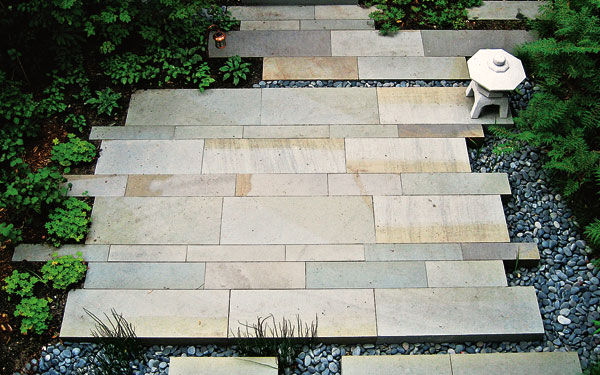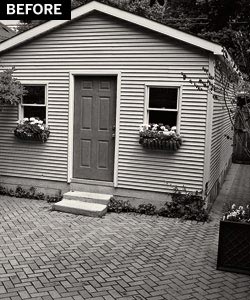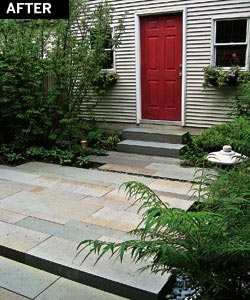
A traditional stone Japanese lantern (the Coburns are fans of Japan’s centuries-old garden style) adds a grace note. |
Minimalism had been taken a little too far in the backyard of Lisa and Andy Coburn’s Roscoe Village row house.
Because the previous owners had had young children, the space had been paved over with bricks to accommodate tricycles and other toys. When the Coburns looked out from their raised deck, they scanned a flat expanse of herringboned brick reaching to the garage and even beyond, to the back fence."It was just really cold and uninviting out there," Lisa says. And the bricks sometimes shed rainwater straight into their basement.

Herringboned brick paving once extended past the garage to the back fence. |
They hired Stephen Prassas (773-879-9048; prassaslandscapestudio.com), a landscape architect and the Coburns’ former neighbor, to rework the space with an Asian sensibility and an eco-friendly strategy. Prassas combined traditional Japanese materials (bamboo and stone) with non-Asian plants (sumac, dogwood, and viburnum) for a look that’s Japan-inspired, not ersatz Japanese. And he cleverly turned the flooding problem into an asset and an environmental plus. Prassas saw, he says,"an opportunity to really transform the space, to do something bold and to solve some problems."
The first issue to address was water. Prassas pulled up many of the bricks and used them to create a dam against water intrusion along the wall of the house. Now that water wouldn’t be going into the basement, where should it go?
How about back where it belongs? Chicago soil can be quite sandy, Prassas notes."I knew if we could just let the water get there, it would be fine," he says."I wanted to make this more a landscape solution than an engineering solution."
Installing a conventional drain would have been an engineered solution. Prassas instead opted to encourage water to linger, wetland-style, in pebbled interstices between smooth rock pavers before percolating into the soil. The effect would be both green—reducing the need for storm sewers is an important step in sustainability—and dynamic. The look of the garden changes subtly with the presence or absence of water among the stones.
Prassas hit on a plan to break up the proposed new bluestone paving with rectilinear rills, or narrow channels. In a curved-street suburban setting, such straight spaces might seem awkward, yet in this boxy urban backyard those channels become an astute abstraction of the city’s grid, still in the Japanese style.

Now artful stonework and shaggy sumacs soften the look. |
Prassas’s use of bamboo is equally thoughtful. Bamboo screens hide storage space below the cedar deck and create a nice sense of enclosure for the yard without looking tacked-on. By replacing the deck’s balusters with bamboo rods, he integrated the structure’s two elements and gave the yard a cohesive attitude.
The plants Prassas chose meet the Coburns’ standard of being native or local species and also suit the aesthetic beautifully. Spiky horsetail reed picks up the bamboo’s verticality and gives the water-holding spaces the look of a pond. (Vigorous spreaders that occur naturally in the Indiana Dunes area, these horsetails are planted in containers so they can’t colonize the whole yard.) And the sumacs have sawtooth-edged leaves that bring in a dose of shagginess to soften the yard’s hard edges.
Prassas concealed a quartet of rain barrels—which the Coburns had wanted but which Prassas considered too ungainly to look at—under the deck and behind the layered bamboo curtain. Tucked out of sight, the four linked barrels collect rainwater from the roof gutters, to be put to work instead of flushed into the city’s sewer system. Now all plant-watering here is done from the barrels.
While she used to visit the backyard mostly to walk across it on her way to or from the garage, Lisa says the space is now a contemplative little destination unto itself, complete with a traditional stone Japanese garden lantern."We can spend a few hours working in the garden on a Sunday," she says,"and hardly even notice that we have the el going by, seven doors down."
Photography: Stephen Prassas


